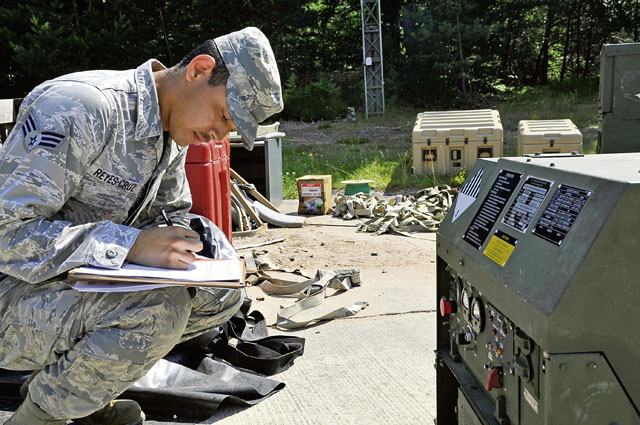
Teamwork comes in all shapes and sizes. In the Air Force, the principle of teamwork is amplified by the Airmen who take part in it.
Members of the 1st Combat Communications Squadron can rapidly establish communications together at locations where methods previously didn’t exist.
They can set up fully operational communication lines in just days and stick around to ensure it all functions properly.
But, they wouldn’t be able to do it without their Airmen who specialize in power and heating, ventilation and air conditioning.
“Without us there would be no power and (air conditioning units), which means the communications guys couldn’t do their job,” said Senior Airman Denis Reyes-Cruz, 1st CBCS electrician. “Without power you can’t do anything, and without the ACU there would be equipment malfunctions.”
This is Reyes-Cruz’s first assignment and being assigned to a combat communications squadron, he gets to see operations he wouldn’t normally be able to see in a typical civil engineer squadron.
“This is my first assignment, and prior to being assigned to the 1st CBCS I haven’t done anything on this scale,” he said. “It’s a good experience and I hope I get to see how everything comes together soon on this exercise.”
The 1st CBCS recently had a weeklong exercise where its members got to experience setting up communications in an environment where they don’t normally train in.
“We’re simulating our mission capabilities in a deployed environment,” Reyes-Cruz said. “I’m supplying them the power for the equipment using one generator. We use a generator that can power 30 live-in tents, even with the gear the members bring for themselves.”
Without the civil engineer Airmen at the exercise, the communications Airmen’s efforts would likely be for nothing.
“Without the heating, ventilation, air conditioning and power Airmen to help us with our equipment,
we wouldn’t really be able to do our job,” said Airman 1st Class Thomas Hack, 1st Combat Communications Squadron radio frequency systems technician. “Even if we could get power for our equipment we would have issues with it overheating.”
The three specialties work day in and day out to ensure communications are established and functioning for a deployed environment.
“Our main job here is to support (the communications Airmen), making sure they have what they
need to do the mission,” Reyes-Cruz said. “We do whatever we can to not fail, because if we fail, the mission fails.”


